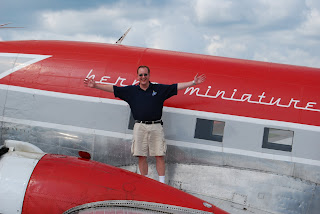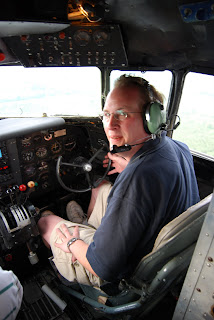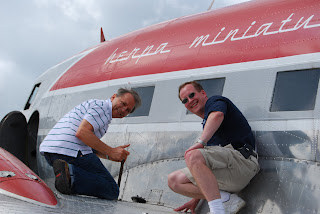Subscribe to Airspeed through iTunes or your favorite other podcatcher. Or listen online right here by clicking: http://media.libsyn.com/media/airspeed/AirspeedDC3SIC2.mp3. It’s all free!
First day of training today. Started out at 8:30 when everyone arrived. We headed out to the aircraft and split into two teams of two. Two did the interior preflight and two did the exterior preflight and then the teams switched.
Took a reasonably long time, but there’s a lot of stuff in a DC-3 that’s not in or on a C-172.
Dan walked us through both the interior and exterior inspections. Here are a few audio outtakes from each of those inspections.
[Audio 1]
We got up sometime around 11:30. We took off from Griffin and headed over to Thomaston-Upson County Airport (KOPN) for pattern work. Gerrit took the first tour in the left seat and did a really good job flying the aircraft. Had most of his callouts memorized and in sequence, but goofed a few. We all did. As much studying as we did before this course, you really have to just get in the airplane and fly it before the memorized events take on substance and start to have practical meaning.
I was second up. Okay. I get to fly the beastie! The ‘three basically flies like a big Apache. The only real difference in the feel is the greater mass and the fact that you turn using a lot more rudder than aileron. In fact, you start the turn with the rudder and follow with as much aileron as is helpful. And you need to figure out by feel how much that is. And it’s nowhere near as much as you might think it would be.
I started out by doing a few turns and by climbing and descending a little. Three or four trips around the pattern on the first flight. It’s actually weird how similar the airspeeds are to a C-172 or other lighter aircraft. You rotate at V2, which is 84 KIAS and make your way to a climb speed of 120 KIAS. But, buy the time you get downwind midfield, you’re basically doing 90 KIAS and then you come over the fence at a little over 75 KIAS.
Touchdown is pretty basic. You retard the throttles as you come over the fence and target maybe 80 KIAS and hold her off a little. The only weird thing is that you can’t descend all the way to a familiar landing sight picture because, at about 10 feet above where you think you should be touching down in a C-172, there’s an obstruction. It’s the main gear of the DC-3 squeaking down. So far, almost every landing has been a surprise that way.
But it’s amazingly well-behaved. I don’t think I’ve ever landed any airplane for the first time as well as I’ve landed the ‘three. Dan is following on the controls a lot and I can’t yet judge how much. But I’ll take some credit for the landings.
Here’s audio from one of my first landings. My callouts are really ragged here, but Dan rolls with it.
[Audio 2]
 Roland was next. I think his second landing was one of the best of the day. After that, we taxied to the ramp and went for some lunch. After lunch, it was preflight inside and out again, then up.
Roland was next. I think his second landing was one of the best of the day. After that, we taxied to the ramp and went for some lunch. After lunch, it was preflight inside and out again, then up.
Tom, the ATP, took the first turn at the controls. He’s really smooth and it’s clear that he’s flown for the airlines. He has as much of an issue internalizing the litany of the pattern as anyone else (and that gives me a little reason for relief), but his underlying technique is very smooth and Dan’s instructional comments to Tom are a lot more direct and assume Tom’s greater familiarity with Cockpit Resource Management (or CRM). It’s clear that there are two airline guys in the front at this point and it’s cool to hear.
Of the four of us, Tom is the only one who has a checkride coming up. The second-in-command course that Roland, Gerrit, and I are taking is a straight-up train-to-standards program with no checkride necessary. Tom, on the other hand, is prepping for a checkride on Tuesday. Dan gets Tom up front in the foremost jumpseat as often as possible and snatches moments when he can to point out things as one of the other guys flies.
I was third to fly on the afternoon flight and got another three landings, one of which was a circle-to-land. The first time around, I ran to the back to start the recorder before taking the left seat and, by the time I got situated, we were a little off-kilter in terms of the pattern. By the time I had her turned around onto something approaching final, we were pretty high and, although we could have gotten her down, Dan decided to have a little fun. We did a high-speed pass.
Yeah, a DC-3 at 160 KIAS barreling down the runway 50 feet off the deck and then a big pull and turn that ends beautifully on downwind for the next trip around.
Here’s audio from one of the trips around the pattern in the afternoon. Note that my callouts are a lot crisper and that I’m getting more of them. Plus, Dan’s holding me to a tougher standard, which is good and what I expect.
This is also going to be my circle-to-land approach.
[Audio 3]
Three last observations before I hit the sack.
First, I’m a fan of describing yourself at an uncontrolled airport by your appearance unless there’s another similar-appearing aircraft in the pattern, in which case you revert to your tail number. I flew with a guy recently who objected pretty strenuously to my doing that on the theory that another similar aircraft could appear in the pattern at any time. I’m not busting his chops here, but I think that, unless you’re at Oshkosh in July, the chances are pretty thin that another DC-3 will be sharing the pattern with you. I delighted in making the calls that “The DC-3 is turning left base.”
Second, this is a great way to train. When you’re not flying, you’re able to watch the other guy flying. You do the callouts in your head and learn from the other guy’s miscues – or get driven to perfect your own callouts when the other guy nails his. I noted in a couple of cases that we were taking cues from each other, integrating stuff that wasn’t expressly on the syllabus into our own routines because they made sense and enhanced the experience. That’s true teamwork.
Lastly, one could fly the ‘three solo, but it’s truly a two-person job. To learn to fly the ‘three is to learn to actively fly with someone else as a synchronized team. You’ll hear the callouts and the responses in the audio here and they’re all pretty necessary in order to safely and efficiently operate the aircraft. This is my first real experience with CRM and with operating the aircraft in the way an airline pilot would expect to. In some respects, the CRM is even tougher to get right than flying an airliner. But I like it a lot.




